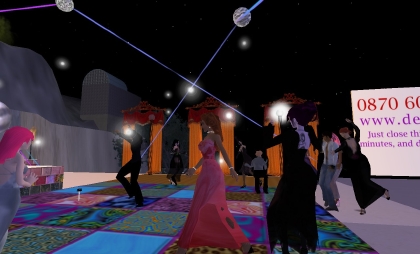Governance as a function of virtual worlds
Now we come to the very difficult example of Second Life. I secretly hope I’m very wrong about this, but I have this distinctive feeling that Second Life is way too different from anything that came before, and very likely, it will be very different from anything that comes next (if it ceases to exist). In a sense, I tended to make fun of Castronova when, asked about why he never studied Second Life as deeply as other virtual worlds, he’s rumoured to have answered that it held no interest to him because it was too similar to real life. He was after economic models without parallels in the real world.
Second Life is uncannily similar to the real world, but not quite, as I have so often described — an enlightened autocracy (where Linden Lab pretty much holds all the power, but benevolently refrains from exercising too much power) promoting laissez-faire capitalism with little or no interference (except for some manipulation of the L$/US$ price). This is pretty much what most European states had in the late 18th century and very early 19th century. Under this model, an aristocracy naturally rises and gets protection. We used to call them “the FIC”, or whatever fancy name was more adequate: a group of residents, that due to their nature, are “closer” to the “decision circle”, and, to a degree, may exercise some influence.
Second Life is also incredibly complex, so it’s not as if the same people influence all decisions — this is not even true at the Linden level except for their CEO. So it’s obvious that independent, volunteer developers who signed the required developer contract with Linden Lab, and regularly contribute code to the SL Viewer, are the ones more close to make decisions. This is even more fundamental than LL’s own employees, who, although generally worked pretty much according to their wishes (remember the Tao of Linden?… right!…), these days they have a bit more planning and even things closely resembling a plan with deadlines. But volunteers are still free to contribute code to do whatever they please, fix the bugs that they are unhappy with, and add the features they like. The needs of the whole mass of residents have little influence. After all, anyone can become a developer and work on what they like most, right? So if you dislike a bug and wish for another feature, just sign the contract and start adding code!
Of course this model is flawed. Just a tiny number of people (a dozen or two at most) actually have the knowledge, the experience, and the required time to become volunteer developers for Linden Lab. So these make all the decisions according to their wishes, to their perceptions of what needs to be done (either in fixing bugs or adding features). It’s nice to have that open collaborative environment between Linden Lab and the residents, but it’s hardly democratic, and absolutely not representative. At most, we residents can make suggestions, and these can be found on the JIRA and elsewhere.
The JIRA, as Prokofy Neva so loudly proclaimed years ago, is hardly “a democratic tool for governance”, and, to the best of my knowledge, it was not intended to be one. It was originally developed to keep track of bugs (and eventually features), but such tools are better used in a “neutral” scenario where bugs are found and reported. The “voting tool”, where users can somehow propose new features and show their support to fix certain bugs, have been erroneously seen as a “democratic” way of influencing LL’s decisions.
This is hardly the case, for several reasons.
First of all, Linden Lab has always said that they wouldn’t set their priorities by what the JIRA said. At best, it would give them pause for thought. Imagine that a feature is added on JIRA saying: “abolish tier”. With a bit of promotion, this could get millions of votes. But it would also lead LL to ruin (since their business model is so closely based on tier revenues). So clearly there are some features that LL would not mind to implement, but several others — many of them, in fact — would be completely pointless to implement.
Then this is a highly specialised environment, but open to non-skilled individuals. “Reduce lag” is naturally something which attracts millions of users, since almost all of us experience lag of some form. But this is not a single issue that can be fixed by simple technological measures; it’s as hard to do as forcing a government to pass a bill to “revert climate change” while scientists are still struggling to understand the complexities of climate prediction with conflicting models. So “reducing lag” is too vague; refining the issue to, say, “make Group IM chat messages come in the right order, no matter how laggy the sim we’re in” is far more feasible; similarly, in real life, governments might pass bills to “tax or fine CO2 polluters heavilly” or “make recycling mandatory”, which are concrete measures that might have a positive, desirable influence on “reverting climate change” while the complexity of the system is still being figured out. However, when the unskilled public is allowed to participate openly in those discussions, it means that they might be voting for “doing magic” in an area that is little understood. LL has no choice but to delete the feature requests for “abolishing lag” because they’re not rationally expressed in a way that a team can address the problem.
Next comes the lack of a “No” feature (Prokofy has for years protested on that). This is typical of a certain model of “democracy” which is just affirmative — the idea behind it being that “negativity has to be avoided” and similar philosophical crap. In truth, what it means is that you either vote in favour of other people’s ideas, or you abstain from voting. Thus, “abstaining” and “being against” are mixed together in the vote count, but they’re not the same thing, and it’s very dangerous to mix those two groups together! A JIRA without a “No” option is hardly a governance tool; it’s little less than a fan club (“Hey, I have this great idea, who is on my side?”). Strangely enough, a lot of organisations implementing governance tools seem to hate giving their users the ability to say no. But that ability is fundamental!
And finally… there are simply too many issues, and too few voters, spread among all the issues. If there were just, say, 50 or 60 issues, and everybody would be aware of the whole context of each issue, then, yes, we could vote in conscience, and Linden Lab could evaluate the results of those votes in order to set their own priorities. But this is not the case. There are perhaps 30 to 40 thousand JIRAs opened (between bugs, features, suggestions…) and far fewer residents than that regularly participating on the JIRA! So, on average, the majority of JIRAs just have a handful of votes, and perhaps some very few have a few hundreds. How “participative” and “representative” are those votes? If a JIRA is really addressing a very serious issue, and gathers 250 votes in a single day, should Linden Lab address it or not? Why should 250 residents influence the Lab’s priorities and affect all the remaining 25 million residents, just because, well, it just happened to be the only JIRA with more than 100 votes in the past month? Such is the problem with direct democracies. In the very few countries where direct democracy is indeed implement, governments struggle with that issue as well, as citizens are asked to vote every day on 3-4 issues; some, of course, will vote every day like good citizens. But the majority simply has no time for all that; which means that the few decisions which get enough votes are made by very few people (and usually always by the same ones: those that have plenty of time!), even though they might have biased opinions and totally lack the knowledge to make an informed decision.
JIRA is not the only way to participate in LL’s decision process. We also have office hours — which hardly allow many to come and have their say, since there is an avatar limit — and many other avenues for open discussion: forums, comments on the official blog, and so forth. And, of course, some “pressure groups” have separate, private discussions with the Lindens. Since LL is mostly a hosting provider — e.g. leasing server space is their core business — it’s natural that they routinely meet with their major clients (those leasing the largest amount of land and contributing towards LL’s income directly) and see how happy they are about LL’s policies. The “Council of Land Barons” is not a “Star Chamber”, it’s simply a corporation openly discussing what to do with their best customers. But, of course, LL being a private company, this happens behind closed doors. And becoming a member of the “Star Chamber” is incredibly expensive! On the other hand, LL naturally views it as “fair” that the biggest investors in SL — their largest customers — should also have a saying in how the virtual world should be run, while the opinion of the common resident, no matter how elegantly formulated and how clever and witty it might be, cannot be accepted if it runs against the interests of LL’s biggest clients. It might not be fair, but it’s hardly rational (for LL) to think otherwise.
Corporations are not democracies and cannot be run efficiently that way!
So now we have a complex “personality split” regarding Second Life. The few governance tools (and meetings are tools too) were designed for a corporation to talk to their customers. As a company, Linden Lab views Second Life as a product, and, as such, implementation of governance tools have to make a positive impact in Second Life as a business. This runs contrary to the other side of the coin, which is Second Life as a virtual social environment. The two have conflicting goals. But we have just one set of tools, biased and aligned to the first, and pretty much ignoring the second aspect of this virtual world. How can both be joined together?
I’m afraid that it might simply be next to impossible. Nevertheless, representative democracy has almost (at least at an idealistic, quasi-utopian level) managed to find an answer to the problem.






